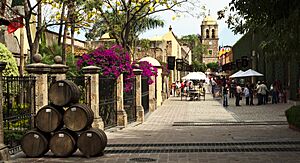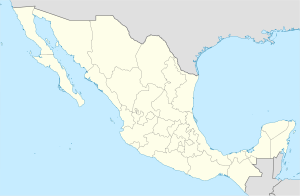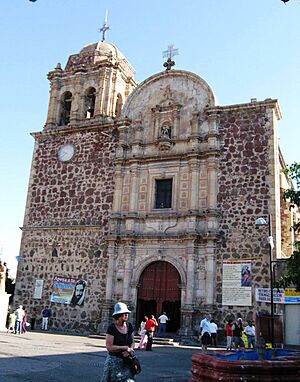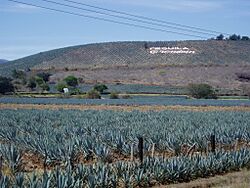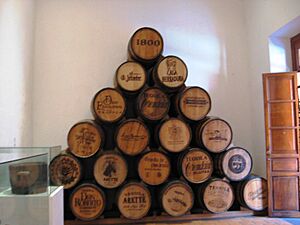Tequila, Jalisco facts for kids
Quick facts for kids
Tequila
|
||
|---|---|---|
|
Town & Municipality
|
||
| Santiago de Tequila | ||
|
||
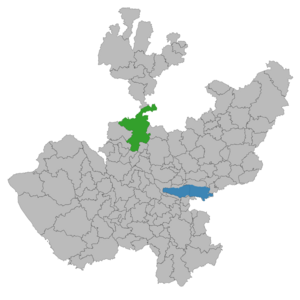
Location of the municipality in Jalisco
|
||
| Country | ||
| State | ||
| Founded | 1530 | |
| Municipal Status | 1850 | |
| Area | ||
| • Municipality | 1,693 km2 (654 sq mi) | |
| • Seat | 6.62 km2 (2.56 sq mi) | |
| Elevation
(of seat)
|
1,180 m (3,870 ft) | |
| Population
(2020 census)
|
||
| • Municipality | 44,353 | |
| • Density | 26.198/km2 (67.852/sq mi) | |
| • Seat | 31,115 | |
| • Seat density | 4,700/km2 (12,173/sq mi) | |
| Time zone | UTC-6 (Central (US Central)) | |
| • Summer (DST) | UTC-5 (Central) | |
| Postal code (of seat) |
46400
|
|
| Demonym | Tequilense | |
| Website | Official site: http://www.tequilajalisco.gob.mx/menui.html | |
Santiago de Tequila is a town and municipality in Jalisco, Mexico. It is about 60 kilometers from the city of Guadalajara. Tequila is famous for being the home of the drink called "tequila." This drink is made from the blue agave plant, which grows naturally in this area.
Long ago, people used the agave plant's heart to make a fermented drink. When the Spanish arrived, they learned to distill this drink. This process created the tequila we know today. Because of the drink's popularity and history, the town and its surrounding area are now a World Heritage Site. In 2003, the Mexican government also named Tequila a "Pueblo Mágico" (Magical Town).
The town's official symbol, its coat of arms, was chosen in 1983. It has a Latin phrase, ALMA LAETA NOBILIS, which means "cheerful and noble soul." The symbols on it include the main church tower, distillery chimneys, the agave plant, and Tequila Mountain.
Contents
Exploring Tequila's Past
The first people in this area were likely from the shaft tomb culture. Later, the Teuchitlan tradition built large circular complexes called guachimontones nearby. Over time, different groups like the Caxcan, Cora, and Huichol people lived here. The main ancient settlement was not where Tequila is today.
How Tequila Was Founded
After the Spanish arrived, they moved west into this region. It became part of a new area called Nueva Galicia. The local people first resisted the Spanish but later decided to surrender peacefully.
The town of Santiago de Tequila was started in 1530 by Franciscan friars. They moved many local people here from Chiquihuitillo Mountain, now known as Tequila Volcano.
Early Challenges and Rebellions
In 1541, local people in Nueva Galicia fought against Spanish rule. People from Tequila joined this rebellion, making their stand on Tequila Mountain. Two monks tried to make peace but were killed. The situation was very serious, and the viceroy, Antonio de Mendoza, came from Mexico City. A rebel leader was captured and agreed to end the rebellion and become Christian for his freedom.
In 1600, Pedro Sánchez de Tagle started a large-scale operation to distill the local agave drink. He also began growing the agave plant on a big scale.
Another rebellion happened in the early 1800s, led by "The Gold Mask." This was stopped by the governor of Nueva Galicia.
Tequila and Mexican Independence
Soon after, the Mexican War of Independence began. Rafael Pérez and his men took over Tequila from the royalist forces. After Mexico became independent, Tequila became an important town in the new state of Jalisco. In 1874, Tequila was officially made a city. This was to honor an event in 1873 when local police and citizens fought off a group of bandits.
Discovering the Town of Tequila
The town of Tequila is home to most of the municipality's people. Its main church is Our Lady of the Purísima Concepción, built in the 1700s. The church has a beautiful stone front with a bell tower. Inside, it has a Neoclassical main altar and a statue of Our Lady of the Conception from 1865.
Important Buildings and Museums
Other notable buildings include the Quinta Sauza, built in the 1830s, and the La Perseverancia distillery from 1873. The Quinta Sauza has a large garden with stone fountains. The La Perseverancia distillery offers guided tours. It also has a museum with paintings, photos, and old machinery.
The National Museum of Tequila (MUNAT) is also in town. It was once a school and then a cultural center. In 2000, it became the first museum in the world dedicated to tequila.
Just 10 kilometers outside Tequila, you can find the Sanctuary of Saint Toribio Romo González. This saint was recently recognized by Pope John Paul II. The Sanctuary is where Saint Toribio was captured and shot during the Cristero War.
Festivals and Traditions
The National Festival of Tequila happens every year from late November to mid-December. During this event, a Tequila Queen is chosen. Distillers offer samples of their tequila. There are also charreada (Mexican rodeo) events, a parade, mariachi music, fireworks, and rides. This festival is held at the same time as the feast day of Tequila's patron saint.
A unique tradition in Tequila is the nightly blessing by the priest. At 9 PM, the priest rings a bell three times and offers blessings. Everyone in town stops what they are doing, even turning off TVs, and stands for the blessing.
The Town and the Famous Drink
The drink called tequila is a type of mezcal. It is made mostly from the blue agave plant. This plant grows naturally in the Tequila area, which is why the drink is named after the town.
How Agave Was Used Long Ago
People have used the agave plant for thousands of years. They used it to prevent soil from washing away, to build houses, and to make cleaning products. The "piña" (the heart of the plant) was cooked as a sweet treat. It was also used to make a fermented alcoholic drink, similar to what is now called pulque. When the Spanish arrived, they found that local people were already growing agave.
The Birth of Distilled Tequila
The Spanish introduced distillation to turn the fermented agave drink into what we now call tequila. This agave drink was already popular and sold in towns. By 1546, soldiers even mixed their water with agave alcohol because drinking water was often unsafe. Agave products became very popular quickly. They were traded far and wide, even hundreds of kilometers away.
The first large distillery was built in 1600. Over time, the demand for the drink grew. This led to the creation of many old, still-working distilleries. Some famous ones include "La Rojeña" (founded 1795) and "La Perseverancia" (now Tequila Sauza, founded 1873).
Tequila's Global Journey
Tequila's popularity grew around the world. Mexicans traveling to Europe found their national drink was famous there. When they returned, they helped spread its popularity at home. This helped tequila become a symbol of Mexican identity. In 1873, the "Mezcal wine" from Jalisco was officially named "Tequila." This helped tell it apart from other mezcal drinks made in southern Mexico.
The Mexican government has protected the name "Tequila" since 1974. Only drinks made from agave grown in certain parts of Mexico can be called Tequila. These areas are in the states of Jalisco, Michoacán, Nayarit, Guanajuato, and parts of Tamaulipas. The term is also limited to specific production facilities.
Many distilleries here produce thousands of liters of tequila daily. However, this is still not enough for the huge international demand, which has grown a lot since the 1980s. Many new tequila brands have also appeared.
The drink's popularity brings thousands of visitors to the area each year. They come to see the agave fields, distilleries, and the National Museum of Tequila. They can also ride the Tequila Express, a train from Guadalajara to Tequila country. This train is very popular, and tickets often need to be bought a month in advance.
Tequila: A World Heritage Site
| Agave Landscape and Ancient Industrial Facilities of Tequila | |
|---|---|
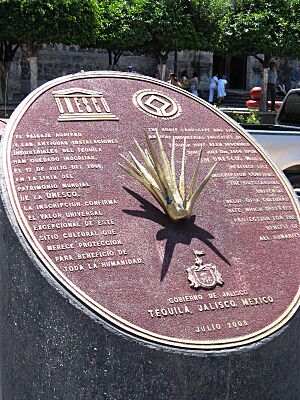
Plaque commemorating Tequila's inclusion into the World Heritage List
|
|
| Location | Tequila, Jalisco, Mexico |
| Area | 35,019 hectares |
| Type | Cultural |
| Criteria | ii, iv, v, vi |
| Designated | 2006 (30th session) |
| Reference no. | 1209 |
| Region | Latin America and the Caribbean |
The rich history and culture of tequila production led to the town of Tequila and its vast agave fields being named a World Heritage Site in 2006. This special area covers over 35,000 hectares. It stretches between the Tequila Volcano and the valley of the Rio Grande de Santiago. This land is covered in fields of blue agave plants.
For more than 2,000 years, this plant has been used to make fermented drinks and cloth. Since the 1500s, it has been used to make the distilled liquor called Tequila. Both the drink and the culture of making it have become a big part of Mexican identity.
Within these fields are the towns of Tequila, Arenal, Amatitan, and Teuchitlán. These towns have large tequila production facilities. The World Heritage Site includes agave fields, distilleries (both active and inactive), and ancient "tabernas" (illegal tequila facilities from the Colonial period). It also includes the towns themselves and the Teuchitlán archeological sites.
Many tequila-making facilities are on large haciendas, some dating back to the 1700s. These buildings are often made of brick and adobe. They feature stucco walls, stone arches, and decorative window frames. Many are decorated with Neoclassical or Baroque styles. Tequila production shows how ancient traditions of making alcohol from agave mixed with European distilling methods. The Teuchitlán archeological site is from one of the first cultures in this area to develop farming.
Tequila Tourism: Explore the Route!
The Tequila Route was created in 2006 to promote tourism in Tequila and nearby towns. These towns include El Arenal, Amatitán, Magdalena, and Teuchitlan. They also have important tequila facilities, as well as cultural and archeological sites. The route also goes through the huge blue agave fields, which are a World Heritage Site.
The Tequila Route is overseen by the Consejo Regulador del Tequila. This group makes sure that the tequila produced here is authentic. Other attractions along the route include ancient ruins, old mansions, and mines where opals and obsidian are found. The archeological sites mostly belong to the Guachimontones culture.
At some old haciendas and distilleries, visitors can even try their hand at making tequila. For example, they can learn how to cut the spines off the agave plant. Most of these places also have tasting rooms and restaurants. The Tequila Volcano is also along the route.
Riding the Tequila Express
The Tequila Express is a special train for tourists that started running in 1997. On Saturdays and Sundays, this train takes passengers through tequila country. Live mariachi music and guides make the trip fun. The train goes to the Hacienda San José del Refugio. Another guided tour, Tequila Adventure, takes people in vans to distilleries like La Cofradía and Mundo Cuervo.
Annual Tequila Fair
The Mexican National Tequila Fair is held every year from November 30 to December 12. It includes parades, charreadas (Mexican rodeos), mariachi music, and fireworks.
Tequila also became famous as the main setting for the TV show Destilando Amor.
Geography of Tequila
Tequila is one of Jalisco's 124 municipalities. It is located just west of the center of the state. Its area is about 1,689 square kilometers. The land varies in height from 700 to 2,900 meters above sea level. The municipality borders Guadalajara's main city area to the east. It also borders the state of Zacatecas to the north. All the towns around Mount Tequila form the larger 'Tequila' region.
The municipality has 207 communities. The largest community outside the town of Tequila is El Salvador. The total population of the municipality is about 38,534 people. Most of these people live in the main town of Tequila.
Mountains and Rivers
The municipality has very rugged land with few flat areas, except in some valleys. The Santiago and El Chico Rivers are the lowest points. The highest point is Tequila Volcano, or Tequila Mountain, at 2,900 meters. This is an inactive volcano that hasn't erupted in over 220,000 years. It stands tall in the center of the municipality. Hiking and other nature activities are possible here. The eastern part of the municipality has the Sierra de los Balcones mountains.
Climate and Nature
Tequila has a tropical climate with some dry periods. It has a dry season in winter and spring, and a rainy season in summer and fall. Temperatures don't change much between summer and winter, averaging about 22.7 degrees Celsius. Higher areas have pine and oak forests. Lower areas have mesquite, nopal, and other plants. The municipality has large areas of pine forest in the mountains. The main rivers are the Santiago, El Chico, and Bolaños, along with many small streams.
| Climate data for Tequila, Jalisco (1991-2020, extremes 1961-present) | |||||||||||||
|---|---|---|---|---|---|---|---|---|---|---|---|---|---|
| Month | Jan | Feb | Mar | Apr | May | Jun | Jul | Aug | Sep | Oct | Nov | Dec | Year |
| Record high °C (°F) | 34.0 (93.2) |
37.0 (98.6) |
40.0 (104.0) |
40.0 (104.0) |
41.0 (105.8) |
45.0 (113.0) |
36.5 (97.7) |
37.5 (99.5) |
36.0 (96.8) |
36.0 (96.8) |
35.0 (95.0) |
34.0 (93.2) |
45.0 (113.0) |
| Mean daily maximum °C (°F) | 27.5 (81.5) |
29.4 (84.9) |
32.3 (90.1) |
34.4 (93.9) |
35.8 (96.4) |
34.1 (93.4) |
30.8 (87.4) |
30.8 (87.4) |
30.2 (86.4) |
30.3 (86.5) |
29.2 (84.6) |
27.9 (82.2) |
31.1 (87.9) |
| Daily mean °C (°F) | 18.6 (65.5) |
20.0 (68.0) |
22.2 (72.0) |
24.2 (75.6) |
26.1 (79.0) |
26.2 (79.2) |
24.2 (75.6) |
24.2 (75.6) |
23.9 (75.0) |
23.1 (73.6) |
21.0 (69.8) |
19.1 (66.4) |
22.7 (72.9) |
| Mean daily minimum °C (°F) | 9.8 (49.6) |
10.6 (51.1) |
12.1 (53.8) |
13.9 (57.0) |
16.3 (61.3) |
18.3 (64.9) |
17.5 (63.5) |
17.6 (63.7) |
17.7 (63.9) |
16.0 (60.8) |
12.8 (55.0) |
10.3 (50.5) |
14.4 (57.9) |
| Record low °C (°F) | 1.0 (33.8) |
3.0 (37.4) |
4.0 (39.2) |
9.0 (48.2) |
9.0 (48.2) |
9.0 (48.2) |
12.0 (53.6) |
1.0 (33.8) |
11.0 (51.8) |
7.0 (44.6) |
5.0 (41.0) |
1.0 (33.8) |
1.0 (33.8) |
| Average precipitation mm (inches) | 22.0 (0.87) |
12.3 (0.48) |
7.9 (0.31) |
1.8 (0.07) |
22.9 (0.90) |
155.0 (6.10) |
253.3 (9.97) |
199.9 (7.87) |
160.1 (6.30) |
49.7 (1.96) |
11.6 (0.46) |
9.7 (0.38) |
906.2 (35.67) |
| Average precipitation days (≥ 0.1 mm) | 1.3 | 1.0 | 0.7 | 0.3 | 2.1 | 10.4 | 17.2 | 15.3 | 12.2 | 4.1 | 1.1 | 0.9 | 66.6 |
| Source: Servicio Meteorológico Nacional | |||||||||||||
Tequila's Economy
Most of the municipality's economy still relies on farming. About 47% of its people work in agriculture. Even though blue agave is very visible, most land is used for growing corn. Other crops include sorghum, beans, mangos, oranges, avocados, and squash. Livestock includes cattle, pigs, goats, horses, and bees.
Making tequila employs about 25% of the people. However, it brings in the most money for the municipality. It makes up almost all of the area's industry. Tourism, especially related to tequila and nature sites, is also growing. For example, the Balneario La Toma is a place with cliffs where people can go rappelling and paragliding. There is also some mining for opals, gold, and silver.
Tequila's Sister Cities
Tequila has special connections with other cities around the world, called sister city relations.
- Cathedral City, California, USA: Tequila has been connected with Cathedral City since 1998. They celebrate this friendship with events like the Taste of Jalisco Festival. This festival honors Mexican culture, music, and food.
- Jelenia Góra, Poland
See also
 In Spanish: Tequila (Jalisco) para niños
In Spanish: Tequila (Jalisco) para niños


